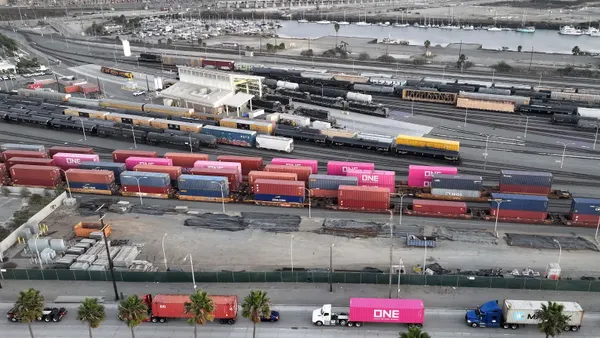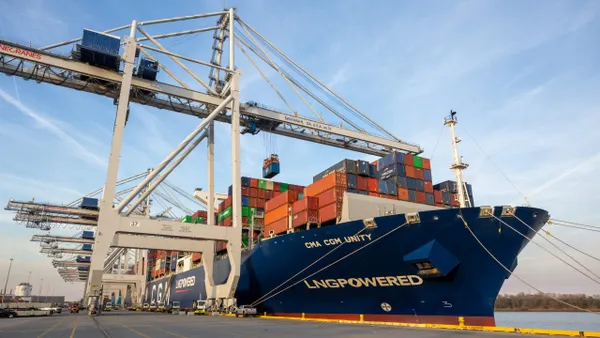Dive Brief:
- The National Retail Federation expects the largest container gateways in the U.S. to continue setting import records through the first half of 2021, according to a forecast from the trade association, released this week.
- Every month between January and June would set a record under NRF's forecast, which shows January import volume up nearly 15% YoY and up more than 26% YoY in February.
- "The import numbers we’re seeing reflect retailers’ expectations for consumer demand to the point that many factories in Asia that normally close for Chinese New Year this month are remaining open to keep up," NRF Vice President for Supply Chain and Customs Policy Jonathan Gold said in a statement.
Dive Insight:
If stakeholders in the ocean shipping industry are hoping for a brief hiatus from high import levels and tight capacity, they might have to wait a little longer if early forecasts materialize over the coming months.
The import forecast covering the next three weeks from the Port of Los Angeles does show the surge continuing in the back half of February. The port expects volume to be up more than 117% between Feb. 14 and Feb. 20, and up more than 345% between Feb. 21 and Feb. 27.
The reason for the impressive surge in imports comes down to the continued strength of consumer demand in recent weeks and months, Gold said in an interview Wednesday.
Spending on goods was up 5.5% YoY in December, as consumers shifted spending away from services, which saw spending fall 7.2% YoY, according to the latest release from the Bureau of Economic Analysis.
"Consumers still have discretionary income, [and] they're buying stuff, since they're not able to go out and do experiences like travel," Gold said.
This demand for imports has resulted in port congestion in Southern California that, as of last week, was affecting every terminal at the ports of Los Angeles and Long Beach, according to Hapag Lloyd.
"It's starting to affect other ports as well," Gold said. Ports in Oakland, California; Savannah, Georgia; and New York are also struggling with some congestion, according to Hapag Lloyd's service alert.
Along with filling ports, the uptick in imports has also stuffed ocean liners to full capacity levels. Gold said retailers are working to buy freight earlier than usual and ensure they have guaranteed space with carriers.
This has all pushed spot rates to impressive levels. Rates from China/East Asia to the North American West Coast have more than doubled where they were at this time last year — up nearly 188% YoY, according to figures from Freightos. As shippers enter contract season, carriers will likely try to use this as leverage to increase contract rates, Gold said.
"I think the shippers are going to push back on that," he said.
While demand has been high in the world of ocean shipping, experts point out that shippers also have some negotiating leverage as they enter contract season. Rolled cargo has ticked up in recent months. And the reliability of carriers has fallen, reaching a record low of 44.6% in December, according to an emailed release from Sea-Intelligence.
"This slump in schedule reliability coincided with the carriers’ introduction of capacity on the major trade lanes, above and beyond what we have seen before," Sea-Intelligence CEO Alan Murphy said in a statement. "With continued widespread port congestion, and with carriers still not letting off capacity-wise (especially on the major trades) not even for Chinese New Year, shippers might not see improving schedule reliability until [Q2 2021]."














